Mock Paper with Solved Assignments and Essays
VerifiedAdded on 2023/06/11
|11
|2785
|239
AI Summary
This mock paper includes solved assignments and essays on Happy Day Caterers Ltd, Watson Co. Ltd, and Biker Corporation. It covers topics such as variances, profitability analysis, break-even point, and activity-based costing. The paper provides strategies to eliminate variances, recommendations to improve financial position, and benefits and limitations of activity-based costing. Course code, course name, and college/university are not mentioned.
Contribute Materials
Your contribution can guide someone’s learning journey. Share your
documents today.
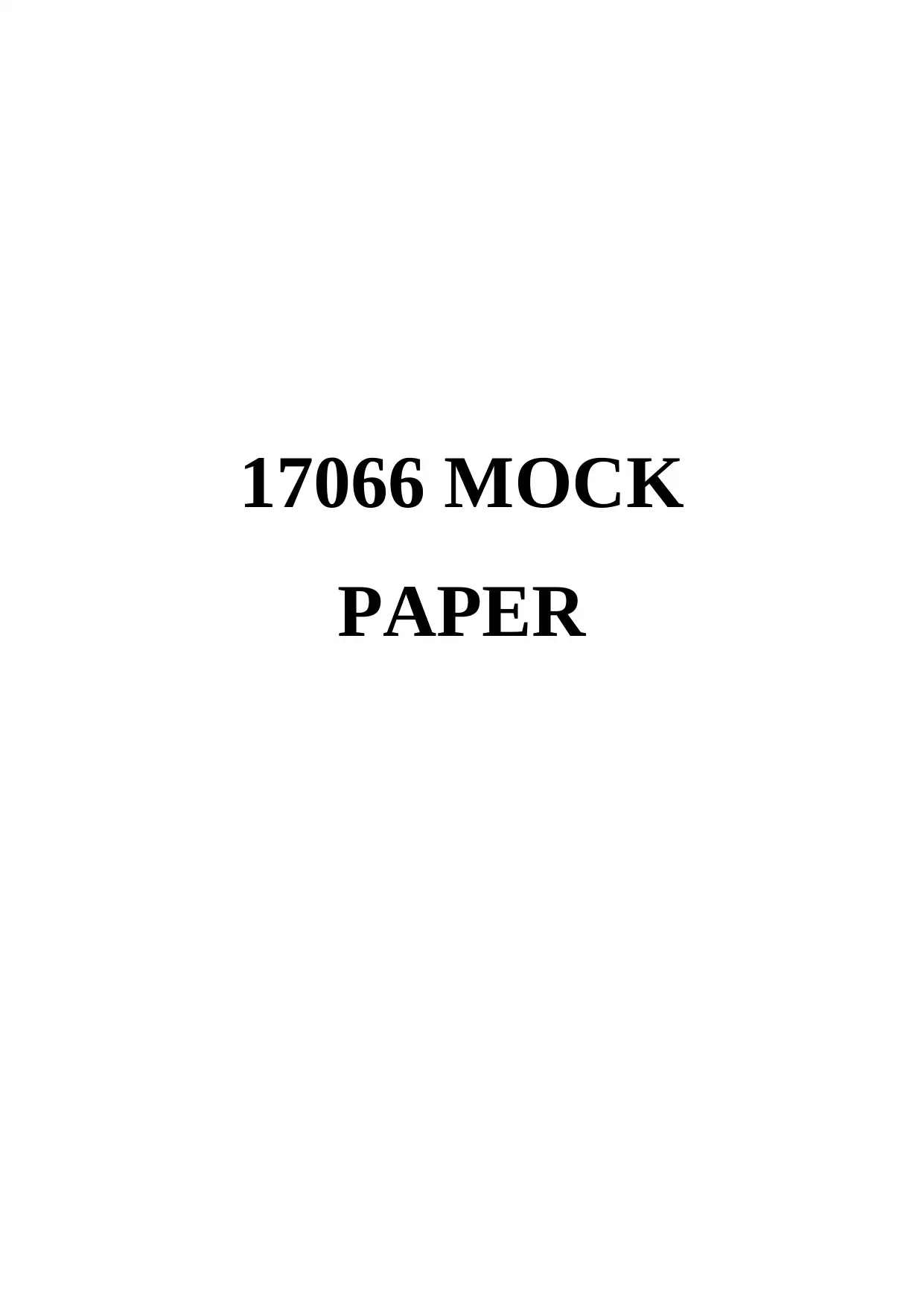
17066 MOCK
PAPER
PAPER
Secure Best Marks with AI Grader
Need help grading? Try our AI Grader for instant feedback on your assignments.
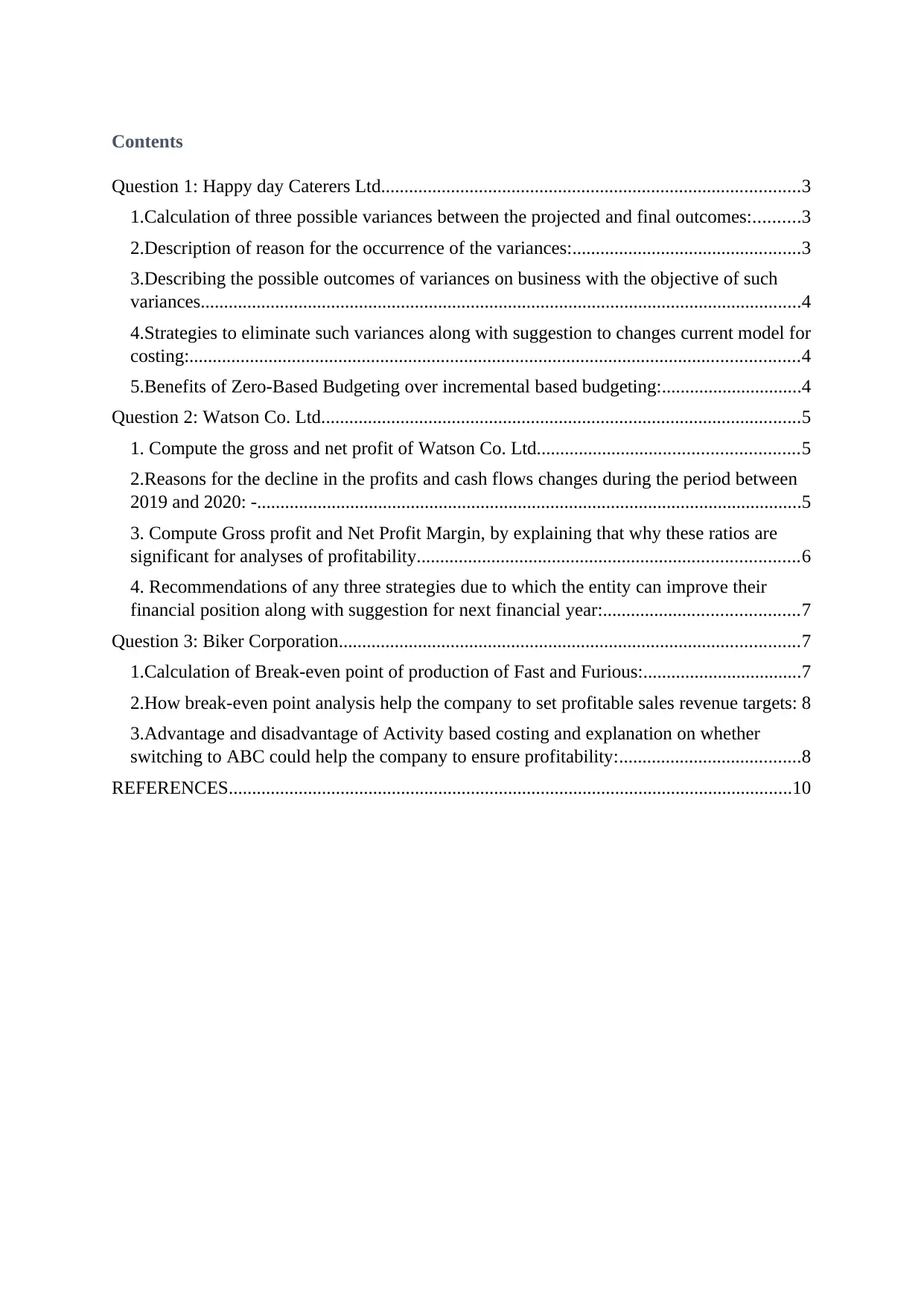
Contents
Question 1: Happy day Caterers Ltd..........................................................................................3
1.Calculation of three possible variances between the projected and final outcomes:..........3
2.Description of reason for the occurrence of the variances:.................................................3
3.Describing the possible outcomes of variances on business with the objective of such
variances.................................................................................................................................4
4.Strategies to eliminate such variances along with suggestion to changes current model for
costing:...................................................................................................................................4
5.Benefits of Zero-Based Budgeting over incremental based budgeting:..............................4
Question 2: Watson Co. Ltd.......................................................................................................5
1. Compute the gross and net profit of Watson Co. Ltd........................................................5
2.Reasons for the decline in the profits and cash flows changes during the period between
2019 and 2020: -.....................................................................................................................5
3. Compute Gross profit and Net Profit Margin, by explaining that why these ratios are
significant for analyses of profitability..................................................................................6
4. Recommendations of any three strategies due to which the entity can improve their
financial position along with suggestion for next financial year:..........................................7
Question 3: Biker Corporation...................................................................................................7
1.Calculation of Break-even point of production of Fast and Furious:..................................7
2.How break-even point analysis help the company to set profitable sales revenue targets: 8
3.Advantage and disadvantage of Activity based costing and explanation on whether
switching to ABC could help the company to ensure profitability:.......................................8
REFERENCES.........................................................................................................................10
Question 1: Happy day Caterers Ltd..........................................................................................3
1.Calculation of three possible variances between the projected and final outcomes:..........3
2.Description of reason for the occurrence of the variances:.................................................3
3.Describing the possible outcomes of variances on business with the objective of such
variances.................................................................................................................................4
4.Strategies to eliminate such variances along with suggestion to changes current model for
costing:...................................................................................................................................4
5.Benefits of Zero-Based Budgeting over incremental based budgeting:..............................4
Question 2: Watson Co. Ltd.......................................................................................................5
1. Compute the gross and net profit of Watson Co. Ltd........................................................5
2.Reasons for the decline in the profits and cash flows changes during the period between
2019 and 2020: -.....................................................................................................................5
3. Compute Gross profit and Net Profit Margin, by explaining that why these ratios are
significant for analyses of profitability..................................................................................6
4. Recommendations of any three strategies due to which the entity can improve their
financial position along with suggestion for next financial year:..........................................7
Question 3: Biker Corporation...................................................................................................7
1.Calculation of Break-even point of production of Fast and Furious:..................................7
2.How break-even point analysis help the company to set profitable sales revenue targets: 8
3.Advantage and disadvantage of Activity based costing and explanation on whether
switching to ABC could help the company to ensure profitability:.......................................8
REFERENCES.........................................................................................................................10
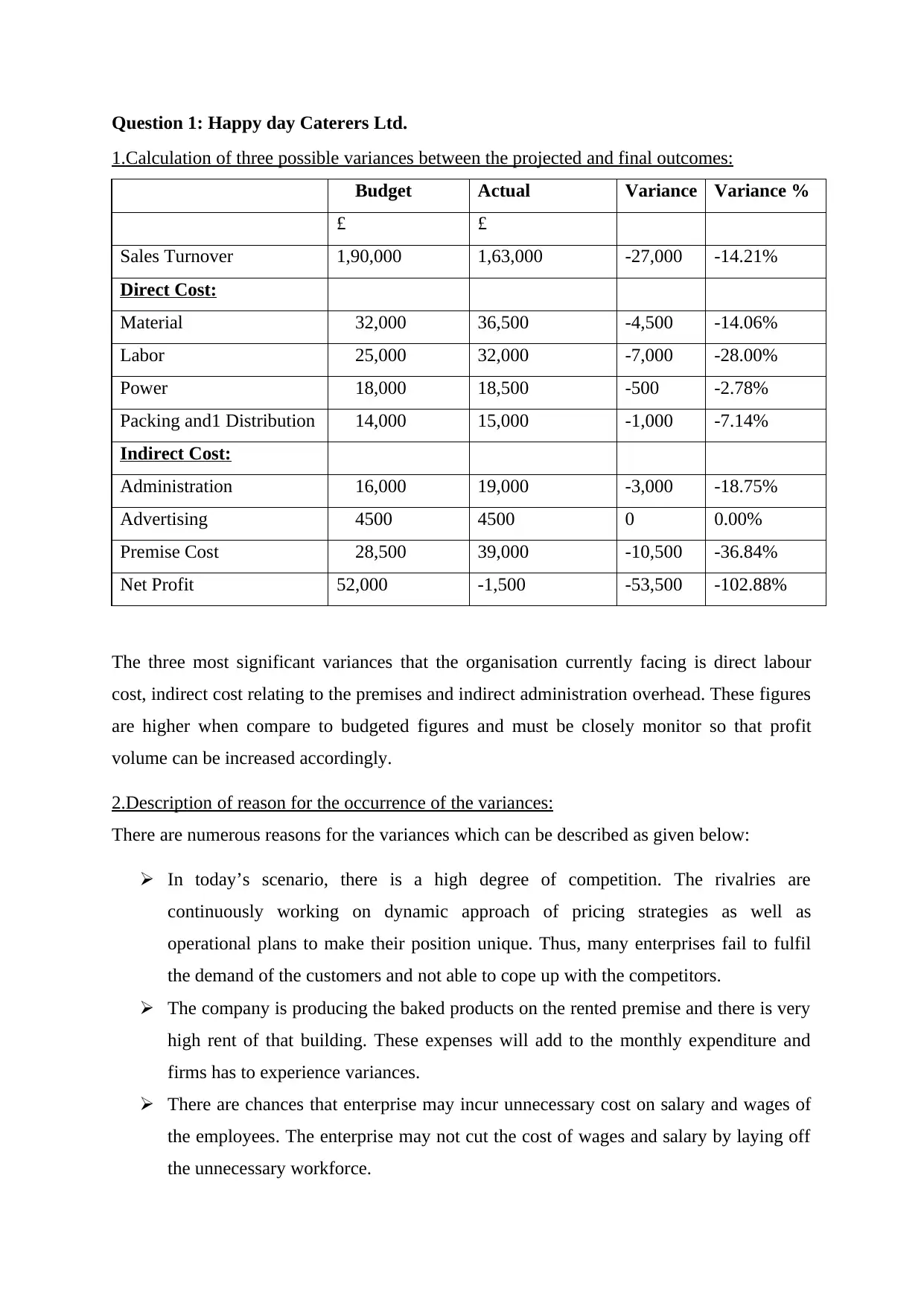
Question 1: Happy day Caterers Ltd.
1.Calculation of three possible variances between the projected and final outcomes:
Budget Actual Variance Variance %
£ £
Sales Turnover 1,90,000 1,63,000 -27,000 -14.21%
Direct Cost:
Material 32,000 36,500 -4,500 -14.06%
Labor 25,000 32,000 -7,000 -28.00%
Power 18,000 18,500 -500 -2.78%
Packing and1 Distribution 14,000 15,000 -1,000 -7.14%
Indirect Cost:
Administration 16,000 19,000 -3,000 -18.75%
Advertising 4500 4500 0 0.00%
Premise Cost 28,500 39,000 -10,500 -36.84%
Net Profit 52,000 -1,500 -53,500 -102.88%
The three most significant variances that the organisation currently facing is direct labour
cost, indirect cost relating to the premises and indirect administration overhead. These figures
are higher when compare to budgeted figures and must be closely monitor so that profit
volume can be increased accordingly.
2.Description of reason for the occurrence of the variances:
There are numerous reasons for the variances which can be described as given below:
In today’s scenario, there is a high degree of competition. The rivalries are
continuously working on dynamic approach of pricing strategies as well as
operational plans to make their position unique. Thus, many enterprises fail to fulfil
the demand of the customers and not able to cope up with the competitors.
The company is producing the baked products on the rented premise and there is very
high rent of that building. These expenses will add to the monthly expenditure and
firms has to experience variances.
There are chances that enterprise may incur unnecessary cost on salary and wages of
the employees. The enterprise may not cut the cost of wages and salary by laying off
the unnecessary workforce.
1.Calculation of three possible variances between the projected and final outcomes:
Budget Actual Variance Variance %
£ £
Sales Turnover 1,90,000 1,63,000 -27,000 -14.21%
Direct Cost:
Material 32,000 36,500 -4,500 -14.06%
Labor 25,000 32,000 -7,000 -28.00%
Power 18,000 18,500 -500 -2.78%
Packing and1 Distribution 14,000 15,000 -1,000 -7.14%
Indirect Cost:
Administration 16,000 19,000 -3,000 -18.75%
Advertising 4500 4500 0 0.00%
Premise Cost 28,500 39,000 -10,500 -36.84%
Net Profit 52,000 -1,500 -53,500 -102.88%
The three most significant variances that the organisation currently facing is direct labour
cost, indirect cost relating to the premises and indirect administration overhead. These figures
are higher when compare to budgeted figures and must be closely monitor so that profit
volume can be increased accordingly.
2.Description of reason for the occurrence of the variances:
There are numerous reasons for the variances which can be described as given below:
In today’s scenario, there is a high degree of competition. The rivalries are
continuously working on dynamic approach of pricing strategies as well as
operational plans to make their position unique. Thus, many enterprises fail to fulfil
the demand of the customers and not able to cope up with the competitors.
The company is producing the baked products on the rented premise and there is very
high rent of that building. These expenses will add to the monthly expenditure and
firms has to experience variances.
There are chances that enterprise may incur unnecessary cost on salary and wages of
the employees. The enterprise may not cut the cost of wages and salary by laying off
the unnecessary workforce.
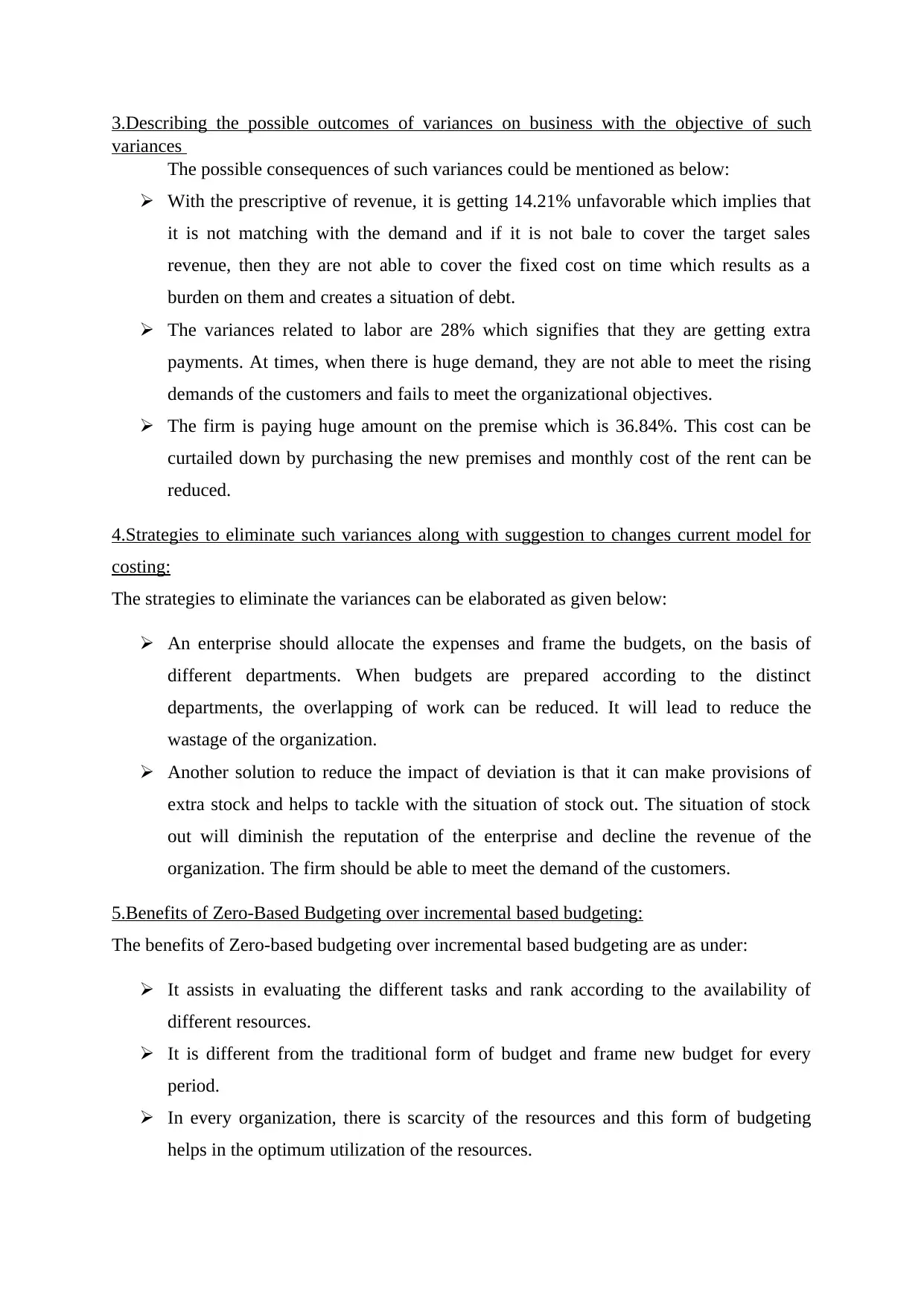
3.Describing the possible outcomes of variances on business with the objective of such
variances
The possible consequences of such variances could be mentioned as below:
With the prescriptive of revenue, it is getting 14.21% unfavorable which implies that
it is not matching with the demand and if it is not bale to cover the target sales
revenue, then they are not able to cover the fixed cost on time which results as a
burden on them and creates a situation of debt.
The variances related to labor are 28% which signifies that they are getting extra
payments. At times, when there is huge demand, they are not able to meet the rising
demands of the customers and fails to meet the organizational objectives.
The firm is paying huge amount on the premise which is 36.84%. This cost can be
curtailed down by purchasing the new premises and monthly cost of the rent can be
reduced.
4.Strategies to eliminate such variances along with suggestion to changes current model for
costing:
The strategies to eliminate the variances can be elaborated as given below:
An enterprise should allocate the expenses and frame the budgets, on the basis of
different departments. When budgets are prepared according to the distinct
departments, the overlapping of work can be reduced. It will lead to reduce the
wastage of the organization.
Another solution to reduce the impact of deviation is that it can make provisions of
extra stock and helps to tackle with the situation of stock out. The situation of stock
out will diminish the reputation of the enterprise and decline the revenue of the
organization. The firm should be able to meet the demand of the customers.
5.Benefits of Zero-Based Budgeting over incremental based budgeting:
The benefits of Zero-based budgeting over incremental based budgeting are as under:
It assists in evaluating the different tasks and rank according to the availability of
different resources.
It is different from the traditional form of budget and frame new budget for every
period.
In every organization, there is scarcity of the resources and this form of budgeting
helps in the optimum utilization of the resources.
variances
The possible consequences of such variances could be mentioned as below:
With the prescriptive of revenue, it is getting 14.21% unfavorable which implies that
it is not matching with the demand and if it is not bale to cover the target sales
revenue, then they are not able to cover the fixed cost on time which results as a
burden on them and creates a situation of debt.
The variances related to labor are 28% which signifies that they are getting extra
payments. At times, when there is huge demand, they are not able to meet the rising
demands of the customers and fails to meet the organizational objectives.
The firm is paying huge amount on the premise which is 36.84%. This cost can be
curtailed down by purchasing the new premises and monthly cost of the rent can be
reduced.
4.Strategies to eliminate such variances along with suggestion to changes current model for
costing:
The strategies to eliminate the variances can be elaborated as given below:
An enterprise should allocate the expenses and frame the budgets, on the basis of
different departments. When budgets are prepared according to the distinct
departments, the overlapping of work can be reduced. It will lead to reduce the
wastage of the organization.
Another solution to reduce the impact of deviation is that it can make provisions of
extra stock and helps to tackle with the situation of stock out. The situation of stock
out will diminish the reputation of the enterprise and decline the revenue of the
organization. The firm should be able to meet the demand of the customers.
5.Benefits of Zero-Based Budgeting over incremental based budgeting:
The benefits of Zero-based budgeting over incremental based budgeting are as under:
It assists in evaluating the different tasks and rank according to the availability of
different resources.
It is different from the traditional form of budget and frame new budget for every
period.
In every organization, there is scarcity of the resources and this form of budgeting
helps in the optimum utilization of the resources.
Secure Best Marks with AI Grader
Need help grading? Try our AI Grader for instant feedback on your assignments.
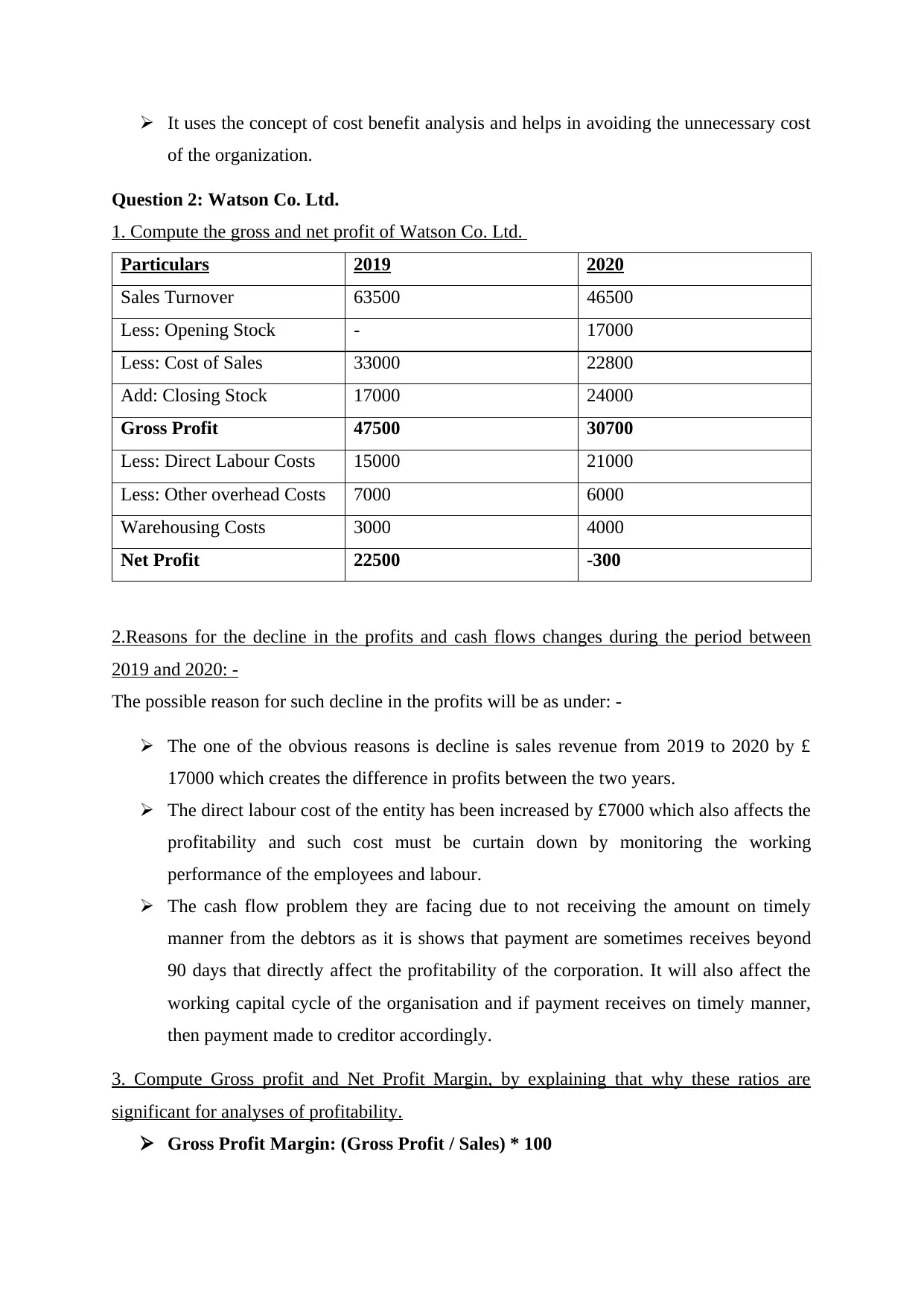
It uses the concept of cost benefit analysis and helps in avoiding the unnecessary cost
of the organization.
Question 2: Watson Co. Ltd.
1. Compute the gross and net profit of Watson Co. Ltd.
Particulars 2019 2020
Sales Turnover 63500 46500
Less: Opening Stock - 17000
Less: Cost of Sales 33000 22800
Add: Closing Stock 17000 24000
Gross Profit 47500 30700
Less: Direct Labour Costs 15000 21000
Less: Other overhead Costs 7000 6000
Warehousing Costs 3000 4000
Net Profit 22500 -300
2.Reasons for the decline in the profits and cash flows changes during the period between
2019 and 2020: -
The possible reason for such decline in the profits will be as under: -
The one of the obvious reasons is decline is sales revenue from 2019 to 2020 by £
17000 which creates the difference in profits between the two years.
The direct labour cost of the entity has been increased by £7000 which also affects the
profitability and such cost must be curtain down by monitoring the working
performance of the employees and labour.
The cash flow problem they are facing due to not receiving the amount on timely
manner from the debtors as it is shows that payment are sometimes receives beyond
90 days that directly affect the profitability of the corporation. It will also affect the
working capital cycle of the organisation and if payment receives on timely manner,
then payment made to creditor accordingly.
3. Compute Gross profit and Net Profit Margin, by explaining that why these ratios are
significant for analyses of profitability.
Gross Profit Margin: (Gross Profit / Sales) * 100
of the organization.
Question 2: Watson Co. Ltd.
1. Compute the gross and net profit of Watson Co. Ltd.
Particulars 2019 2020
Sales Turnover 63500 46500
Less: Opening Stock - 17000
Less: Cost of Sales 33000 22800
Add: Closing Stock 17000 24000
Gross Profit 47500 30700
Less: Direct Labour Costs 15000 21000
Less: Other overhead Costs 7000 6000
Warehousing Costs 3000 4000
Net Profit 22500 -300
2.Reasons for the decline in the profits and cash flows changes during the period between
2019 and 2020: -
The possible reason for such decline in the profits will be as under: -
The one of the obvious reasons is decline is sales revenue from 2019 to 2020 by £
17000 which creates the difference in profits between the two years.
The direct labour cost of the entity has been increased by £7000 which also affects the
profitability and such cost must be curtain down by monitoring the working
performance of the employees and labour.
The cash flow problem they are facing due to not receiving the amount on timely
manner from the debtors as it is shows that payment are sometimes receives beyond
90 days that directly affect the profitability of the corporation. It will also affect the
working capital cycle of the organisation and if payment receives on timely manner,
then payment made to creditor accordingly.
3. Compute Gross profit and Net Profit Margin, by explaining that why these ratios are
significant for analyses of profitability.
Gross Profit Margin: (Gross Profit / Sales) * 100
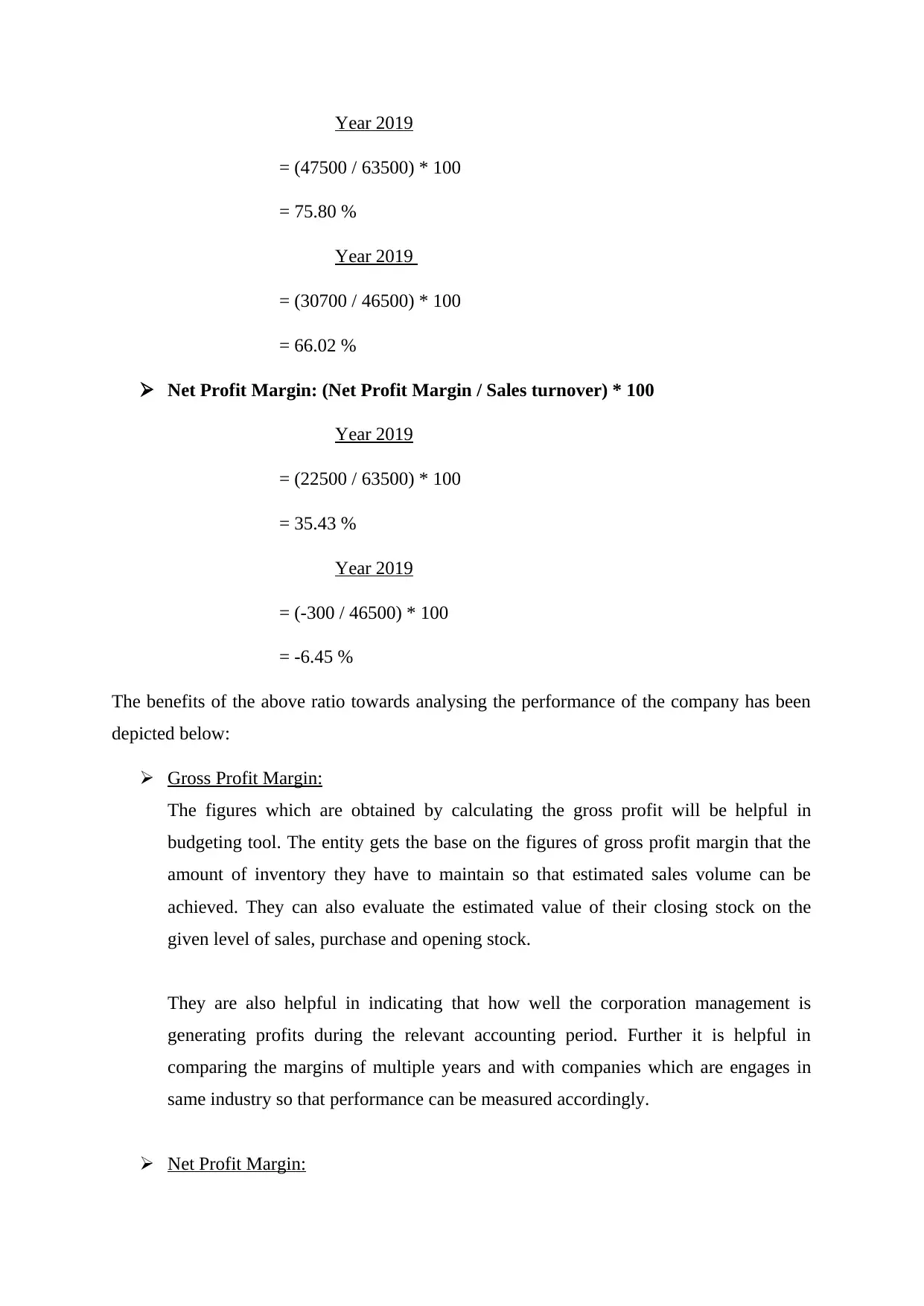
Year 2019
= (47500 / 63500) * 100
= 75.80 %
Year 2019
= (30700 / 46500) * 100
= 66.02 %
Net Profit Margin: (Net Profit Margin / Sales turnover) * 100
Year 2019
= (22500 / 63500) * 100
= 35.43 %
Year 2019
= (-300 / 46500) * 100
= -6.45 %
The benefits of the above ratio towards analysing the performance of the company has been
depicted below:
Gross Profit Margin:
The figures which are obtained by calculating the gross profit will be helpful in
budgeting tool. The entity gets the base on the figures of gross profit margin that the
amount of inventory they have to maintain so that estimated sales volume can be
achieved. They can also evaluate the estimated value of their closing stock on the
given level of sales, purchase and opening stock.
They are also helpful in indicating that how well the corporation management is
generating profits during the relevant accounting period. Further it is helpful in
comparing the margins of multiple years and with companies which are engages in
same industry so that performance can be measured accordingly.
Net Profit Margin:
= (47500 / 63500) * 100
= 75.80 %
Year 2019
= (30700 / 46500) * 100
= 66.02 %
Net Profit Margin: (Net Profit Margin / Sales turnover) * 100
Year 2019
= (22500 / 63500) * 100
= 35.43 %
Year 2019
= (-300 / 46500) * 100
= -6.45 %
The benefits of the above ratio towards analysing the performance of the company has been
depicted below:
Gross Profit Margin:
The figures which are obtained by calculating the gross profit will be helpful in
budgeting tool. The entity gets the base on the figures of gross profit margin that the
amount of inventory they have to maintain so that estimated sales volume can be
achieved. They can also evaluate the estimated value of their closing stock on the
given level of sales, purchase and opening stock.
They are also helpful in indicating that how well the corporation management is
generating profits during the relevant accounting period. Further it is helpful in
comparing the margins of multiple years and with companies which are engages in
same industry so that performance can be measured accordingly.
Net Profit Margin:
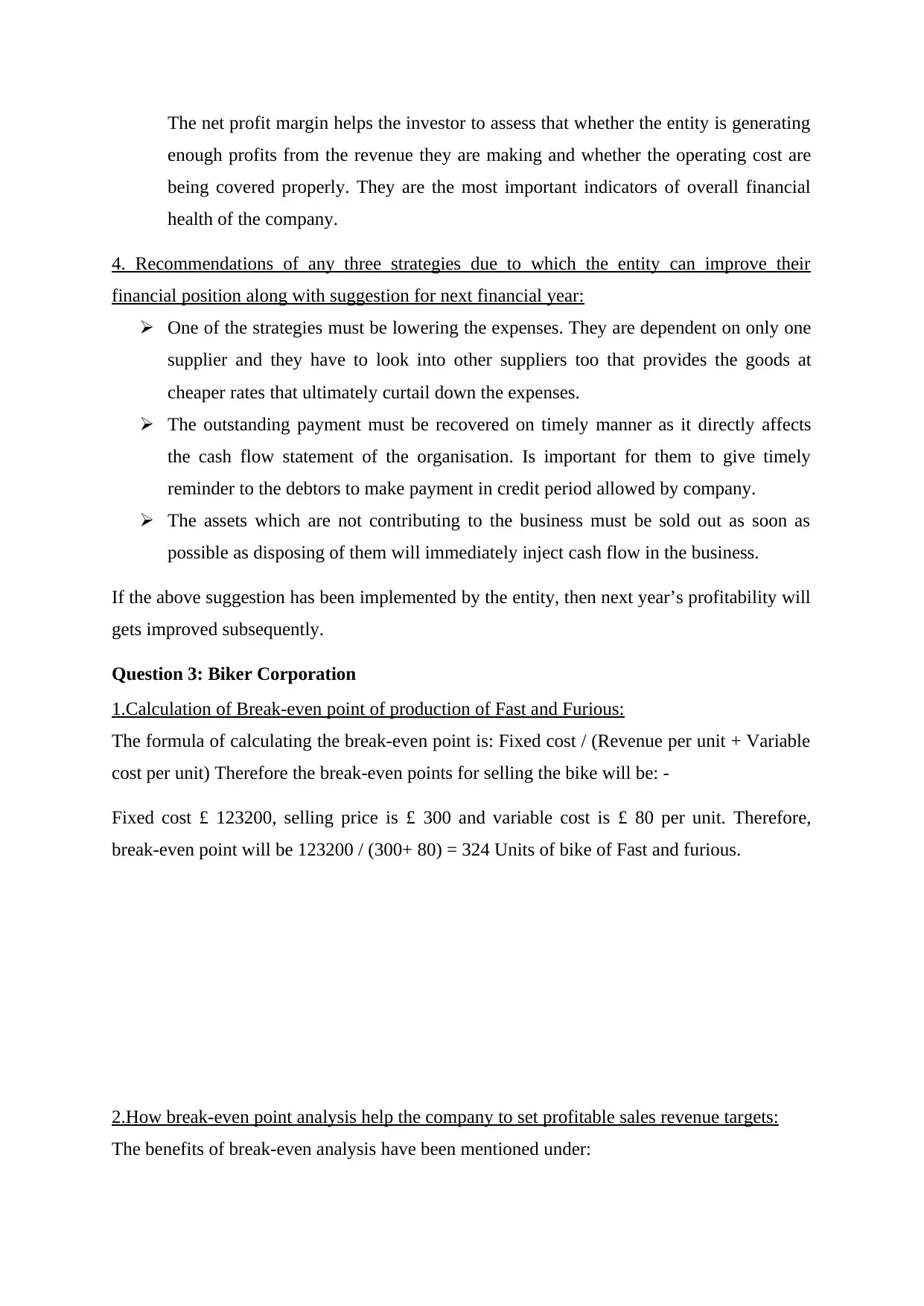
The net profit margin helps the investor to assess that whether the entity is generating
enough profits from the revenue they are making and whether the operating cost are
being covered properly. They are the most important indicators of overall financial
health of the company.
4. Recommendations of any three strategies due to which the entity can improve their
financial position along with suggestion for next financial year:
One of the strategies must be lowering the expenses. They are dependent on only one
supplier and they have to look into other suppliers too that provides the goods at
cheaper rates that ultimately curtail down the expenses.
The outstanding payment must be recovered on timely manner as it directly affects
the cash flow statement of the organisation. Is important for them to give timely
reminder to the debtors to make payment in credit period allowed by company.
The assets which are not contributing to the business must be sold out as soon as
possible as disposing of them will immediately inject cash flow in the business.
If the above suggestion has been implemented by the entity, then next year’s profitability will
gets improved subsequently.
Question 3: Biker Corporation
1.Calculation of Break-even point of production of Fast and Furious:
The formula of calculating the break-even point is: Fixed cost / (Revenue per unit + Variable
cost per unit) Therefore the break-even points for selling the bike will be: -
Fixed cost £ 123200, selling price is £ 300 and variable cost is £ 80 per unit. Therefore,
break-even point will be 123200 / (300+ 80) = 324 Units of bike of Fast and furious.
2.How break-even point analysis help the company to set profitable sales revenue targets:
The benefits of break-even analysis have been mentioned under:
enough profits from the revenue they are making and whether the operating cost are
being covered properly. They are the most important indicators of overall financial
health of the company.
4. Recommendations of any three strategies due to which the entity can improve their
financial position along with suggestion for next financial year:
One of the strategies must be lowering the expenses. They are dependent on only one
supplier and they have to look into other suppliers too that provides the goods at
cheaper rates that ultimately curtail down the expenses.
The outstanding payment must be recovered on timely manner as it directly affects
the cash flow statement of the organisation. Is important for them to give timely
reminder to the debtors to make payment in credit period allowed by company.
The assets which are not contributing to the business must be sold out as soon as
possible as disposing of them will immediately inject cash flow in the business.
If the above suggestion has been implemented by the entity, then next year’s profitability will
gets improved subsequently.
Question 3: Biker Corporation
1.Calculation of Break-even point of production of Fast and Furious:
The formula of calculating the break-even point is: Fixed cost / (Revenue per unit + Variable
cost per unit) Therefore the break-even points for selling the bike will be: -
Fixed cost £ 123200, selling price is £ 300 and variable cost is £ 80 per unit. Therefore,
break-even point will be 123200 / (300+ 80) = 324 Units of bike of Fast and furious.
2.How break-even point analysis help the company to set profitable sales revenue targets:
The benefits of break-even analysis have been mentioned under:
Paraphrase This Document
Need a fresh take? Get an instant paraphrase of this document with our AI Paraphraser
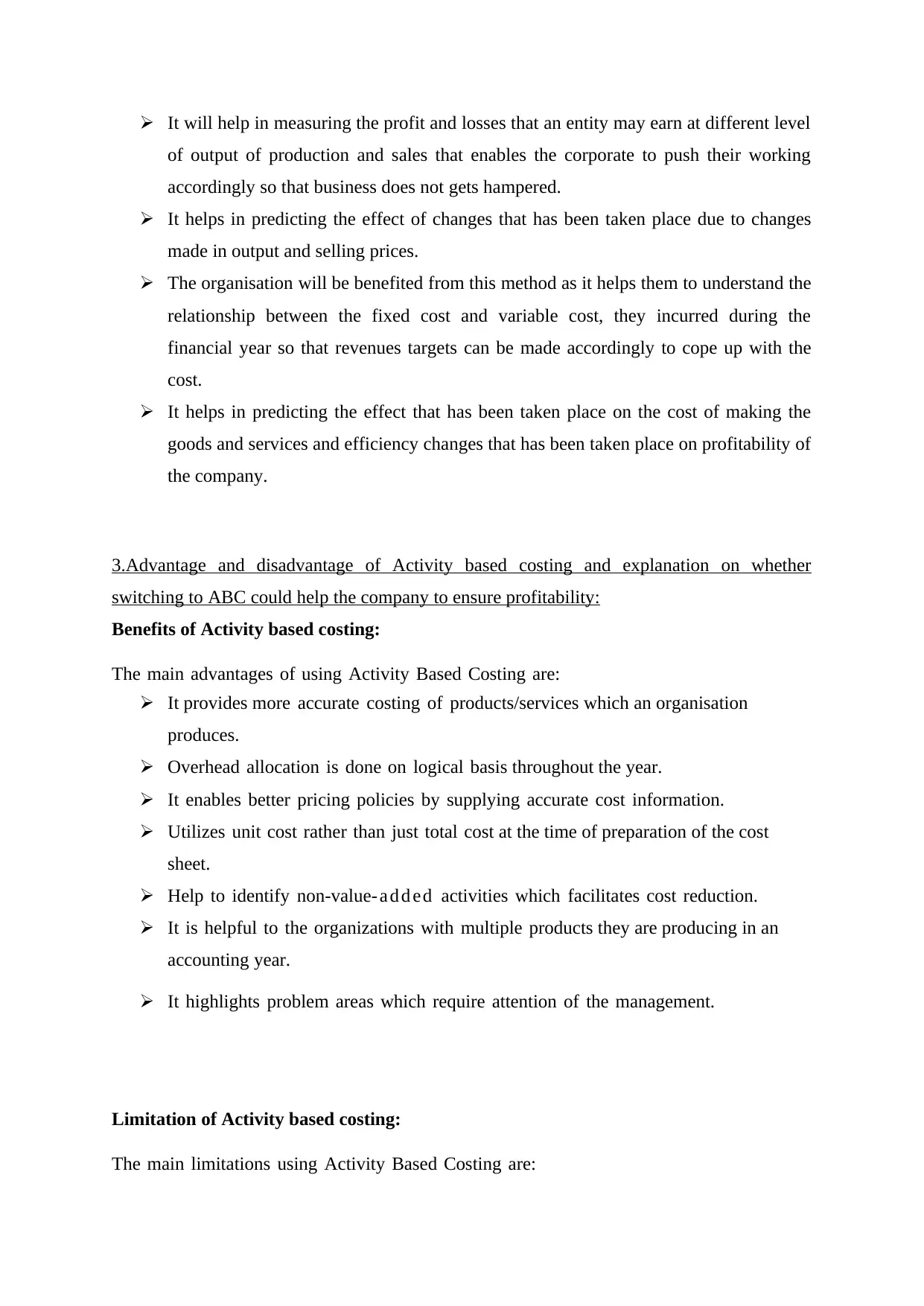
It will help in measuring the profit and losses that an entity may earn at different level
of output of production and sales that enables the corporate to push their working
accordingly so that business does not gets hampered.
It helps in predicting the effect of changes that has been taken place due to changes
made in output and selling prices.
The organisation will be benefited from this method as it helps them to understand the
relationship between the fixed cost and variable cost, they incurred during the
financial year so that revenues targets can be made accordingly to cope up with the
cost.
It helps in predicting the effect that has been taken place on the cost of making the
goods and services and efficiency changes that has been taken place on profitability of
the company.
3.Advantage and disadvantage of Activity based costing and explanation on whether
switching to ABC could help the company to ensure profitability:
Benefits of Activity based costing:
The main advantages of using Activity Based Costing are:
It provides more accurate costing of products/services which an organisation
produces.
Overhead allocation is done on logical basis throughout the year.
It enables better pricing policies by supplying accurate cost information.
Utilizes unit cost rather than just total cost at the time of preparation of the cost
sheet.
Help to identify non-value- a d d e d activities which facilitates cost reduction.
It is helpful to the organizations with multiple products they are producing in an
accounting year.
It highlights problem areas which require attention of the management.
Limitation of Activity based costing:
The main limitations using Activity Based Costing are:
of output of production and sales that enables the corporate to push their working
accordingly so that business does not gets hampered.
It helps in predicting the effect of changes that has been taken place due to changes
made in output and selling prices.
The organisation will be benefited from this method as it helps them to understand the
relationship between the fixed cost and variable cost, they incurred during the
financial year so that revenues targets can be made accordingly to cope up with the
cost.
It helps in predicting the effect that has been taken place on the cost of making the
goods and services and efficiency changes that has been taken place on profitability of
the company.
3.Advantage and disadvantage of Activity based costing and explanation on whether
switching to ABC could help the company to ensure profitability:
Benefits of Activity based costing:
The main advantages of using Activity Based Costing are:
It provides more accurate costing of products/services which an organisation
produces.
Overhead allocation is done on logical basis throughout the year.
It enables better pricing policies by supplying accurate cost information.
Utilizes unit cost rather than just total cost at the time of preparation of the cost
sheet.
Help to identify non-value- a d d e d activities which facilitates cost reduction.
It is helpful to the organizations with multiple products they are producing in an
accounting year.
It highlights problem areas which require attention of the management.
Limitation of Activity based costing:
The main limitations using Activity Based Costing are:
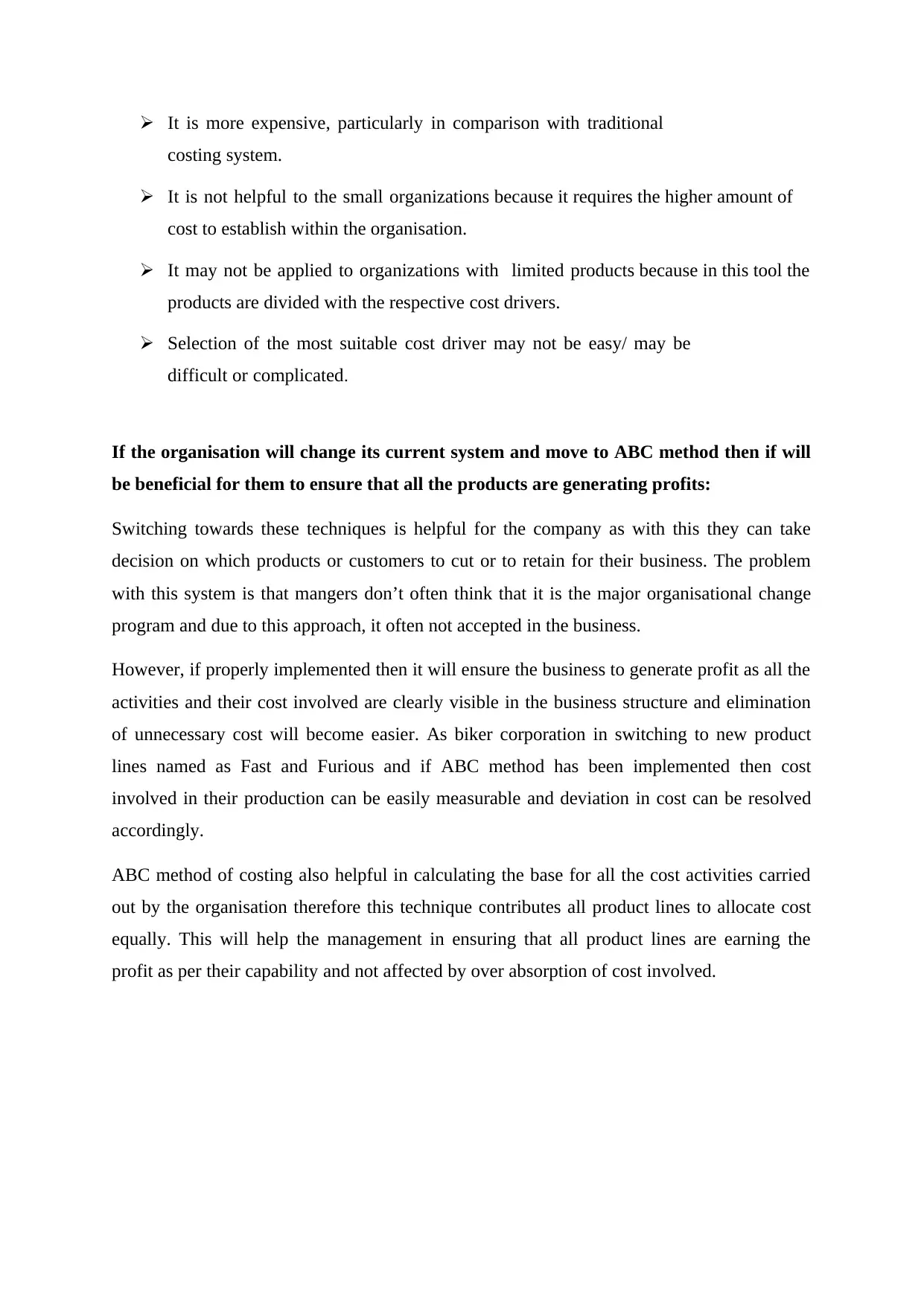
It is more expensive, particularly in comparison with traditional
costing system.
It is not helpful to the small organizations because it requires the higher amount of
cost to establish within the organisation.
It may not be applied to organizations with limited products because in this tool the
products are divided with the respective cost drivers.
Selection of the most suitable cost driver may not be easy/ may be
difficult or complicated.
If the organisation will change its current system and move to ABC method then if will
be beneficial for them to ensure that all the products are generating profits:
Switching towards these techniques is helpful for the company as with this they can take
decision on which products or customers to cut or to retain for their business. The problem
with this system is that mangers don’t often think that it is the major organisational change
program and due to this approach, it often not accepted in the business.
However, if properly implemented then it will ensure the business to generate profit as all the
activities and their cost involved are clearly visible in the business structure and elimination
of unnecessary cost will become easier. As biker corporation in switching to new product
lines named as Fast and Furious and if ABC method has been implemented then cost
involved in their production can be easily measurable and deviation in cost can be resolved
accordingly.
ABC method of costing also helpful in calculating the base for all the cost activities carried
out by the organisation therefore this technique contributes all product lines to allocate cost
equally. This will help the management in ensuring that all product lines are earning the
profit as per their capability and not affected by over absorption of cost involved.
costing system.
It is not helpful to the small organizations because it requires the higher amount of
cost to establish within the organisation.
It may not be applied to organizations with limited products because in this tool the
products are divided with the respective cost drivers.
Selection of the most suitable cost driver may not be easy/ may be
difficult or complicated.
If the organisation will change its current system and move to ABC method then if will
be beneficial for them to ensure that all the products are generating profits:
Switching towards these techniques is helpful for the company as with this they can take
decision on which products or customers to cut or to retain for their business. The problem
with this system is that mangers don’t often think that it is the major organisational change
program and due to this approach, it often not accepted in the business.
However, if properly implemented then it will ensure the business to generate profit as all the
activities and their cost involved are clearly visible in the business structure and elimination
of unnecessary cost will become easier. As biker corporation in switching to new product
lines named as Fast and Furious and if ABC method has been implemented then cost
involved in their production can be easily measurable and deviation in cost can be resolved
accordingly.
ABC method of costing also helpful in calculating the base for all the cost activities carried
out by the organisation therefore this technique contributes all product lines to allocate cost
equally. This will help the management in ensuring that all product lines are earning the
profit as per their capability and not affected by over absorption of cost involved.

Secure Best Marks with AI Grader
Need help grading? Try our AI Grader for instant feedback on your assignments.
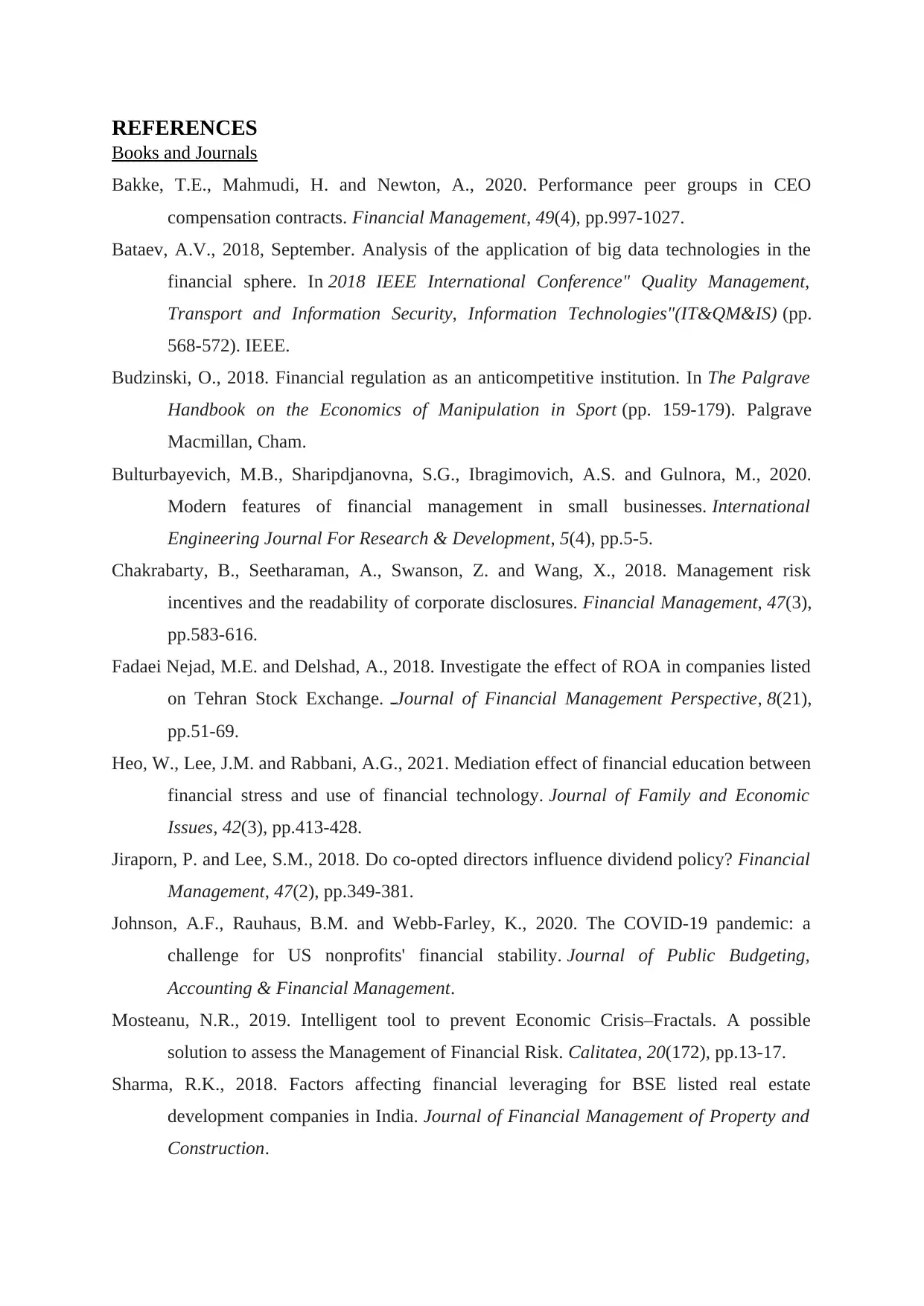
REFERENCES
Books and Journals
Bakke, T.E., Mahmudi, H. and Newton, A., 2020. Performance peer groups in CEO
compensation contracts. Financial Management, 49(4), pp.997-1027.
Bataev, A.V., 2018, September. Analysis of the application of big data technologies in the
financial sphere. In 2018 IEEE International Conference" Quality Management,
Transport and Information Security, Information Technologies"(IT&QM&IS) (pp.
568-572). IEEE.
Budzinski, O., 2018. Financial regulation as an anticompetitive institution. In The Palgrave
Handbook on the Economics of Manipulation in Sport (pp. 159-179). Palgrave
Macmillan, Cham.
Bulturbayevich, M.B., Sharipdjanovna, S.G., Ibragimovich, A.S. and Gulnora, M., 2020.
Modern features of financial management in small businesses. International
Engineering Journal For Research & Development, 5(4), pp.5-5.
Chakrabarty, B., Seetharaman, A., Swanson, Z. and Wang, X., 2018. Management risk
incentives and the readability of corporate disclosures. Financial Management, 47(3),
pp.583-616.
Fadaei Nejad, M.E. and Delshad, A., 2018. Investigate the effect of ROA in companies listed
on Tehran Stock Exchange. ـJournal of Financial Management Perspective, 8(21),
pp.51-69.
Heo, W., Lee, J.M. and Rabbani, A.G., 2021. Mediation effect of financial education between
financial stress and use of financial technology. Journal of Family and Economic
Issues, 42(3), pp.413-428.
Jiraporn, P. and Lee, S.M., 2018. Do co‐opted directors influence dividend policy? Financial
Management, 47(2), pp.349-381.
Johnson, A.F., Rauhaus, B.M. and Webb-Farley, K., 2020. The COVID-19 pandemic: a
challenge for US nonprofits' financial stability. Journal of Public Budgeting,
Accounting & Financial Management.
Mosteanu, N.R., 2019. Intelligent tool to prevent Economic Crisis–Fractals. A possible
solution to assess the Management of Financial Risk. Calitatea, 20(172), pp.13-17.
Sharma, R.K., 2018. Factors affecting financial leveraging for BSE listed real estate
development companies in India. Journal of Financial Management of Property and
Construction.
Books and Journals
Bakke, T.E., Mahmudi, H. and Newton, A., 2020. Performance peer groups in CEO
compensation contracts. Financial Management, 49(4), pp.997-1027.
Bataev, A.V., 2018, September. Analysis of the application of big data technologies in the
financial sphere. In 2018 IEEE International Conference" Quality Management,
Transport and Information Security, Information Technologies"(IT&QM&IS) (pp.
568-572). IEEE.
Budzinski, O., 2018. Financial regulation as an anticompetitive institution. In The Palgrave
Handbook on the Economics of Manipulation in Sport (pp. 159-179). Palgrave
Macmillan, Cham.
Bulturbayevich, M.B., Sharipdjanovna, S.G., Ibragimovich, A.S. and Gulnora, M., 2020.
Modern features of financial management in small businesses. International
Engineering Journal For Research & Development, 5(4), pp.5-5.
Chakrabarty, B., Seetharaman, A., Swanson, Z. and Wang, X., 2018. Management risk
incentives and the readability of corporate disclosures. Financial Management, 47(3),
pp.583-616.
Fadaei Nejad, M.E. and Delshad, A., 2018. Investigate the effect of ROA in companies listed
on Tehran Stock Exchange. ـJournal of Financial Management Perspective, 8(21),
pp.51-69.
Heo, W., Lee, J.M. and Rabbani, A.G., 2021. Mediation effect of financial education between
financial stress and use of financial technology. Journal of Family and Economic
Issues, 42(3), pp.413-428.
Jiraporn, P. and Lee, S.M., 2018. Do co‐opted directors influence dividend policy? Financial
Management, 47(2), pp.349-381.
Johnson, A.F., Rauhaus, B.M. and Webb-Farley, K., 2020. The COVID-19 pandemic: a
challenge for US nonprofits' financial stability. Journal of Public Budgeting,
Accounting & Financial Management.
Mosteanu, N.R., 2019. Intelligent tool to prevent Economic Crisis–Fractals. A possible
solution to assess the Management of Financial Risk. Calitatea, 20(172), pp.13-17.
Sharma, R.K., 2018. Factors affecting financial leveraging for BSE listed real estate
development companies in India. Journal of Financial Management of Property and
Construction.
1 out of 11
Related Documents
Your All-in-One AI-Powered Toolkit for Academic Success.
+13062052269
info@desklib.com
Available 24*7 on WhatsApp / Email
![[object Object]](/_next/static/media/star-bottom.7253800d.svg)
Unlock your academic potential
© 2024 | Zucol Services PVT LTD | All rights reserved.


